Project 1: Gasoline Market Analysis
VerifiedAdded on 2020/02/18
|11
|2560
|46
Project
AI Summary
This project provides a comprehensive economic analysis of the US gasoline market to inform an investment decision regarding a gasoline station and convenience store venture. It examines the law of demand and supply, analyzing the determinants of gasoline demand and supply, including price elasticity. Macroeconomic factors like GDP growth, interest rates, and government spending are considered, alongside microeconomic factors like weather events and technological advancements. The analysis concludes with recommendations for the investor, emphasizing the importance of considering both short-term and long-term market conditions and the potential profitability of the venture given the current economic climate.
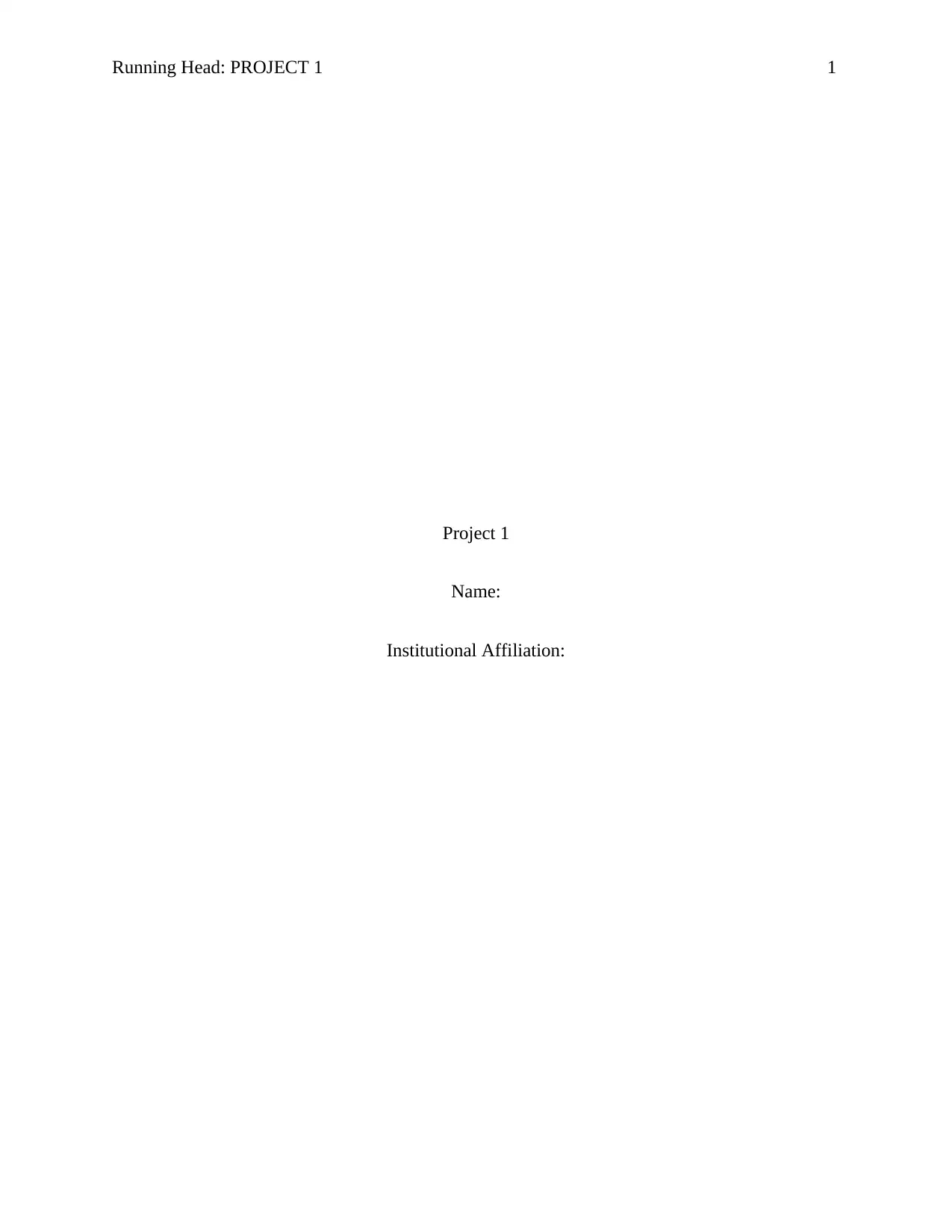
Running Head: PROJECT 1 1
Project 1
Name:
Institutional Affiliation:
Project 1
Name:
Institutional Affiliation:
Paraphrase This Document
Need a fresh take? Get an instant paraphrase of this document with our AI Paraphraser
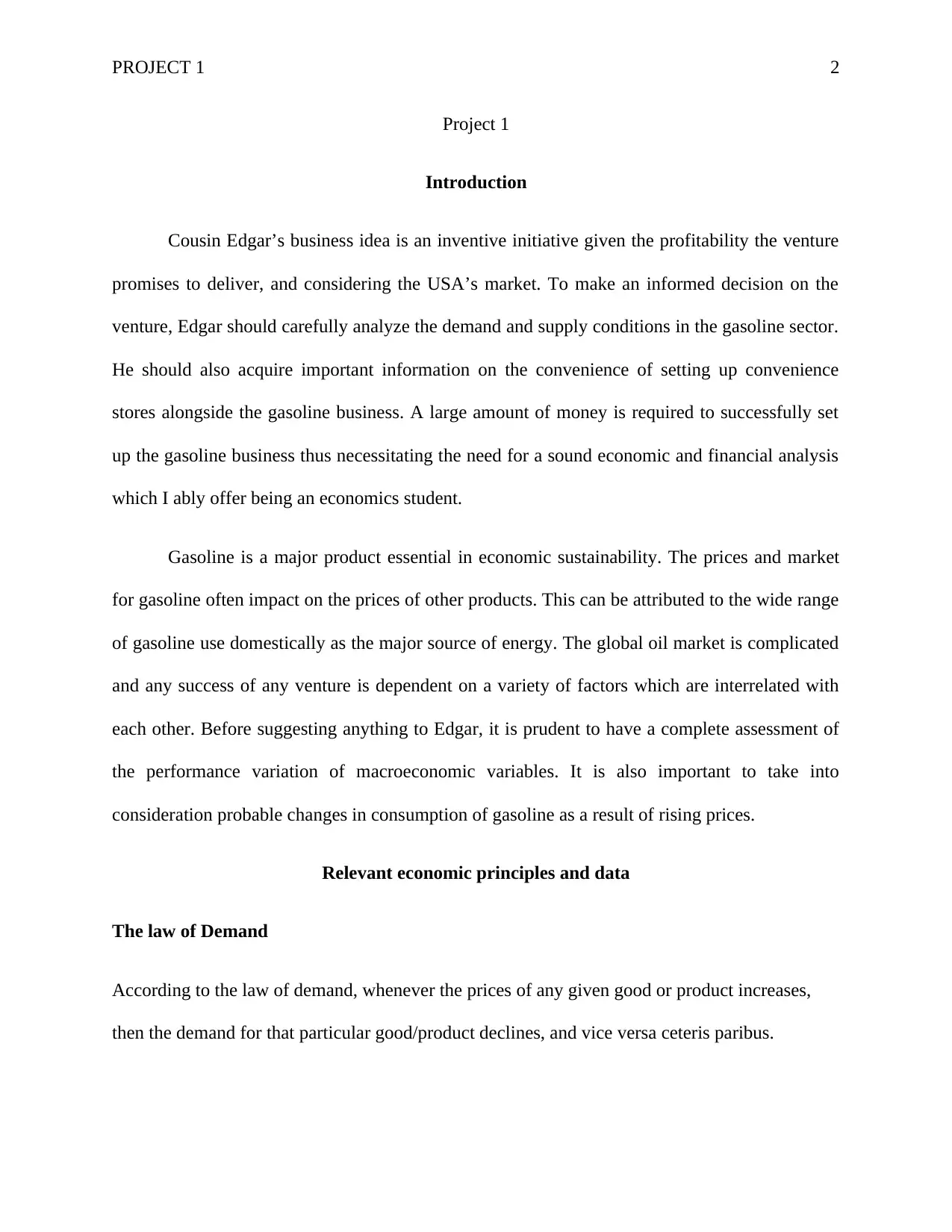
PROJECT 1 2
Project 1
Introduction
Cousin Edgar’s business idea is an inventive initiative given the profitability the venture
promises to deliver, and considering the USA’s market. To make an informed decision on the
venture, Edgar should carefully analyze the demand and supply conditions in the gasoline sector.
He should also acquire important information on the convenience of setting up convenience
stores alongside the gasoline business. A large amount of money is required to successfully set
up the gasoline business thus necessitating the need for a sound economic and financial analysis
which I ably offer being an economics student.
Gasoline is a major product essential in economic sustainability. The prices and market
for gasoline often impact on the prices of other products. This can be attributed to the wide range
of gasoline use domestically as the major source of energy. The global oil market is complicated
and any success of any venture is dependent on a variety of factors which are interrelated with
each other. Before suggesting anything to Edgar, it is prudent to have a complete assessment of
the performance variation of macroeconomic variables. It is also important to take into
consideration probable changes in consumption of gasoline as a result of rising prices.
Relevant economic principles and data
The law of Demand
According to the law of demand, whenever the prices of any given good or product increases,
then the demand for that particular good/product declines, and vice versa ceteris paribus.
Project 1
Introduction
Cousin Edgar’s business idea is an inventive initiative given the profitability the venture
promises to deliver, and considering the USA’s market. To make an informed decision on the
venture, Edgar should carefully analyze the demand and supply conditions in the gasoline sector.
He should also acquire important information on the convenience of setting up convenience
stores alongside the gasoline business. A large amount of money is required to successfully set
up the gasoline business thus necessitating the need for a sound economic and financial analysis
which I ably offer being an economics student.
Gasoline is a major product essential in economic sustainability. The prices and market
for gasoline often impact on the prices of other products. This can be attributed to the wide range
of gasoline use domestically as the major source of energy. The global oil market is complicated
and any success of any venture is dependent on a variety of factors which are interrelated with
each other. Before suggesting anything to Edgar, it is prudent to have a complete assessment of
the performance variation of macroeconomic variables. It is also important to take into
consideration probable changes in consumption of gasoline as a result of rising prices.
Relevant economic principles and data
The law of Demand
According to the law of demand, whenever the prices of any given good or product increases,
then the demand for that particular good/product declines, and vice versa ceteris paribus.
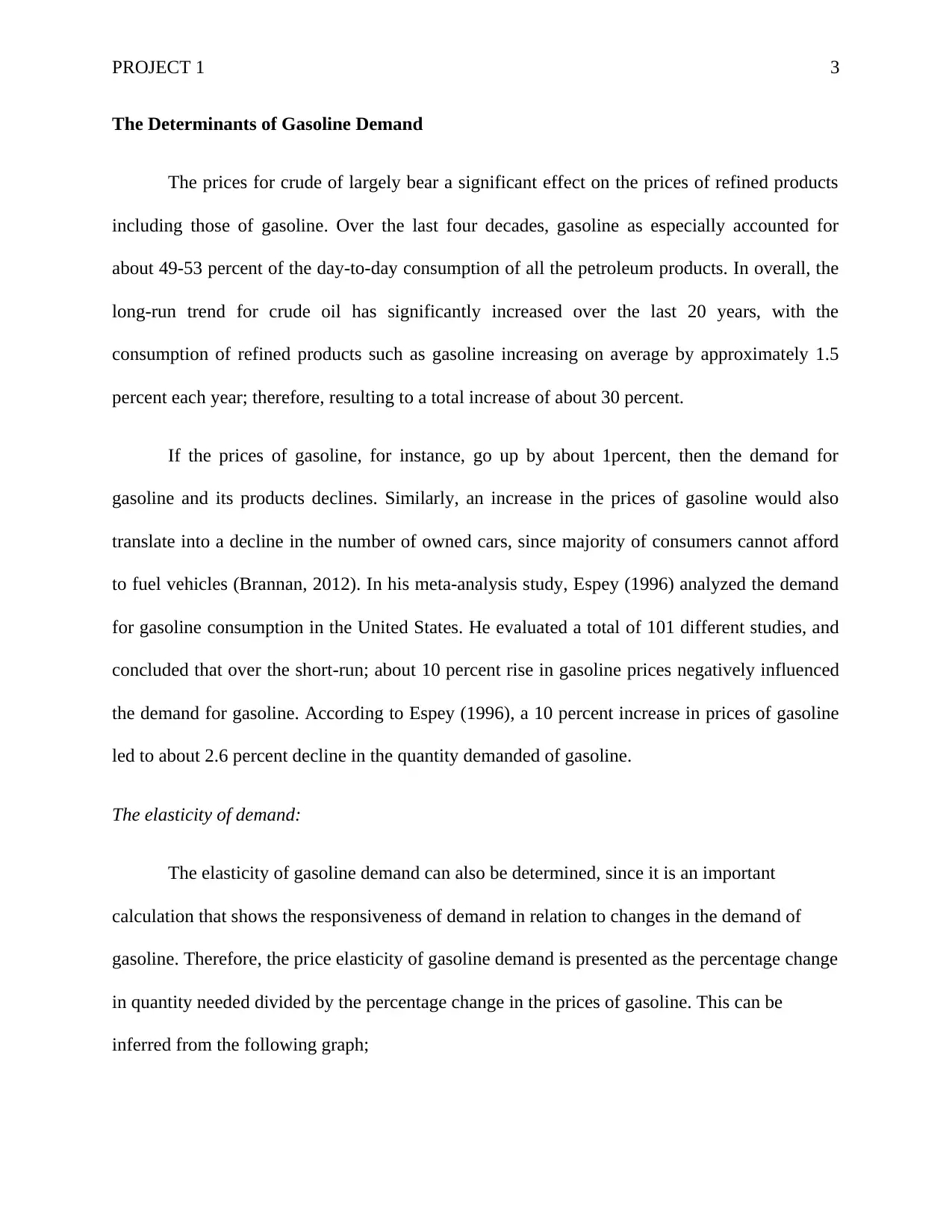
PROJECT 1 3
The Determinants of Gasoline Demand
The prices for crude of largely bear a significant effect on the prices of refined products
including those of gasoline. Over the last four decades, gasoline as especially accounted for
about 49-53 percent of the day-to-day consumption of all the petroleum products. In overall, the
long-run trend for crude oil has significantly increased over the last 20 years, with the
consumption of refined products such as gasoline increasing on average by approximately 1.5
percent each year; therefore, resulting to a total increase of about 30 percent.
If the prices of gasoline, for instance, go up by about 1percent, then the demand for
gasoline and its products declines. Similarly, an increase in the prices of gasoline would also
translate into a decline in the number of owned cars, since majority of consumers cannot afford
to fuel vehicles (Brannan, 2012). In his meta-analysis study, Espey (1996) analyzed the demand
for gasoline consumption in the United States. He evaluated a total of 101 different studies, and
concluded that over the short-run; about 10 percent rise in gasoline prices negatively influenced
the demand for gasoline. According to Espey (1996), a 10 percent increase in prices of gasoline
led to about 2.6 percent decline in the quantity demanded of gasoline.
The elasticity of demand:
The elasticity of gasoline demand can also be determined, since it is an important
calculation that shows the responsiveness of demand in relation to changes in the demand of
gasoline. Therefore, the price elasticity of gasoline demand is presented as the percentage change
in quantity needed divided by the percentage change in the prices of gasoline. This can be
inferred from the following graph;
The Determinants of Gasoline Demand
The prices for crude of largely bear a significant effect on the prices of refined products
including those of gasoline. Over the last four decades, gasoline as especially accounted for
about 49-53 percent of the day-to-day consumption of all the petroleum products. In overall, the
long-run trend for crude oil has significantly increased over the last 20 years, with the
consumption of refined products such as gasoline increasing on average by approximately 1.5
percent each year; therefore, resulting to a total increase of about 30 percent.
If the prices of gasoline, for instance, go up by about 1percent, then the demand for
gasoline and its products declines. Similarly, an increase in the prices of gasoline would also
translate into a decline in the number of owned cars, since majority of consumers cannot afford
to fuel vehicles (Brannan, 2012). In his meta-analysis study, Espey (1996) analyzed the demand
for gasoline consumption in the United States. He evaluated a total of 101 different studies, and
concluded that over the short-run; about 10 percent rise in gasoline prices negatively influenced
the demand for gasoline. According to Espey (1996), a 10 percent increase in prices of gasoline
led to about 2.6 percent decline in the quantity demanded of gasoline.
The elasticity of demand:
The elasticity of gasoline demand can also be determined, since it is an important
calculation that shows the responsiveness of demand in relation to changes in the demand of
gasoline. Therefore, the price elasticity of gasoline demand is presented as the percentage change
in quantity needed divided by the percentage change in the prices of gasoline. This can be
inferred from the following graph;
⊘ This is a preview!⊘
Do you want full access?
Subscribe today to unlock all pages.

Trusted by 1+ million students worldwide
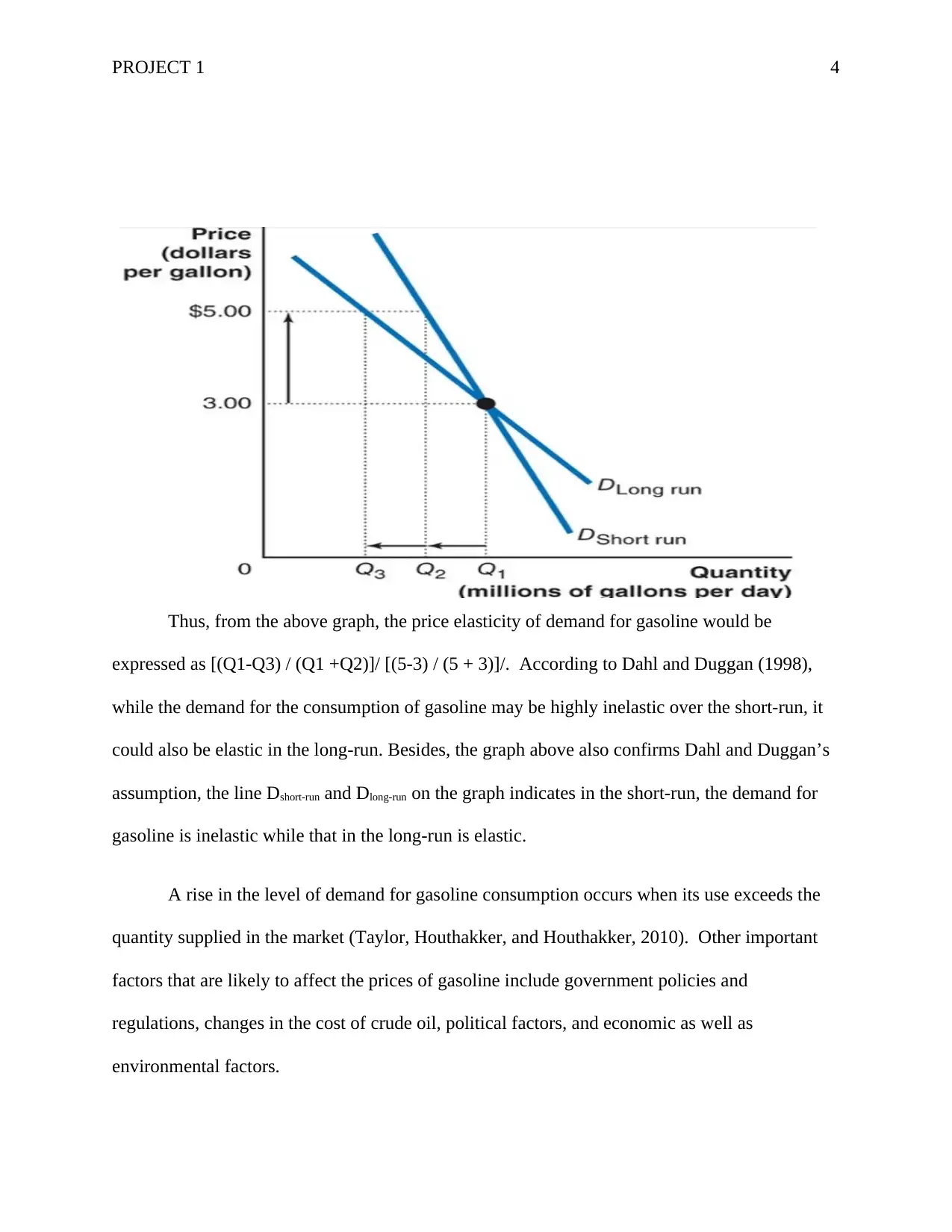
PROJECT 1 4
Thus, from the above graph, the price elasticity of demand for gasoline would be
expressed as [(Q1-Q3) / (Q1 +Q2)]/ [(5-3) / (5 + 3)]/. According to Dahl and Duggan (1998),
while the demand for the consumption of gasoline may be highly inelastic over the short-run, it
could also be elastic in the long-run. Besides, the graph above also confirms Dahl and Duggan’s
assumption, the line Dshort-run and Dlong-run on the graph indicates in the short-run, the demand for
gasoline is inelastic while that in the long-run is elastic.
A rise in the level of demand for gasoline consumption occurs when its use exceeds the
quantity supplied in the market (Taylor, Houthakker, and Houthakker, 2010). Other important
factors that are likely to affect the prices of gasoline include government policies and
regulations, changes in the cost of crude oil, political factors, and economic as well as
environmental factors.
Thus, from the above graph, the price elasticity of demand for gasoline would be
expressed as [(Q1-Q3) / (Q1 +Q2)]/ [(5-3) / (5 + 3)]/. According to Dahl and Duggan (1998),
while the demand for the consumption of gasoline may be highly inelastic over the short-run, it
could also be elastic in the long-run. Besides, the graph above also confirms Dahl and Duggan’s
assumption, the line Dshort-run and Dlong-run on the graph indicates in the short-run, the demand for
gasoline is inelastic while that in the long-run is elastic.
A rise in the level of demand for gasoline consumption occurs when its use exceeds the
quantity supplied in the market (Taylor, Houthakker, and Houthakker, 2010). Other important
factors that are likely to affect the prices of gasoline include government policies and
regulations, changes in the cost of crude oil, political factors, and economic as well as
environmental factors.
Paraphrase This Document
Need a fresh take? Get an instant paraphrase of this document with our AI Paraphraser
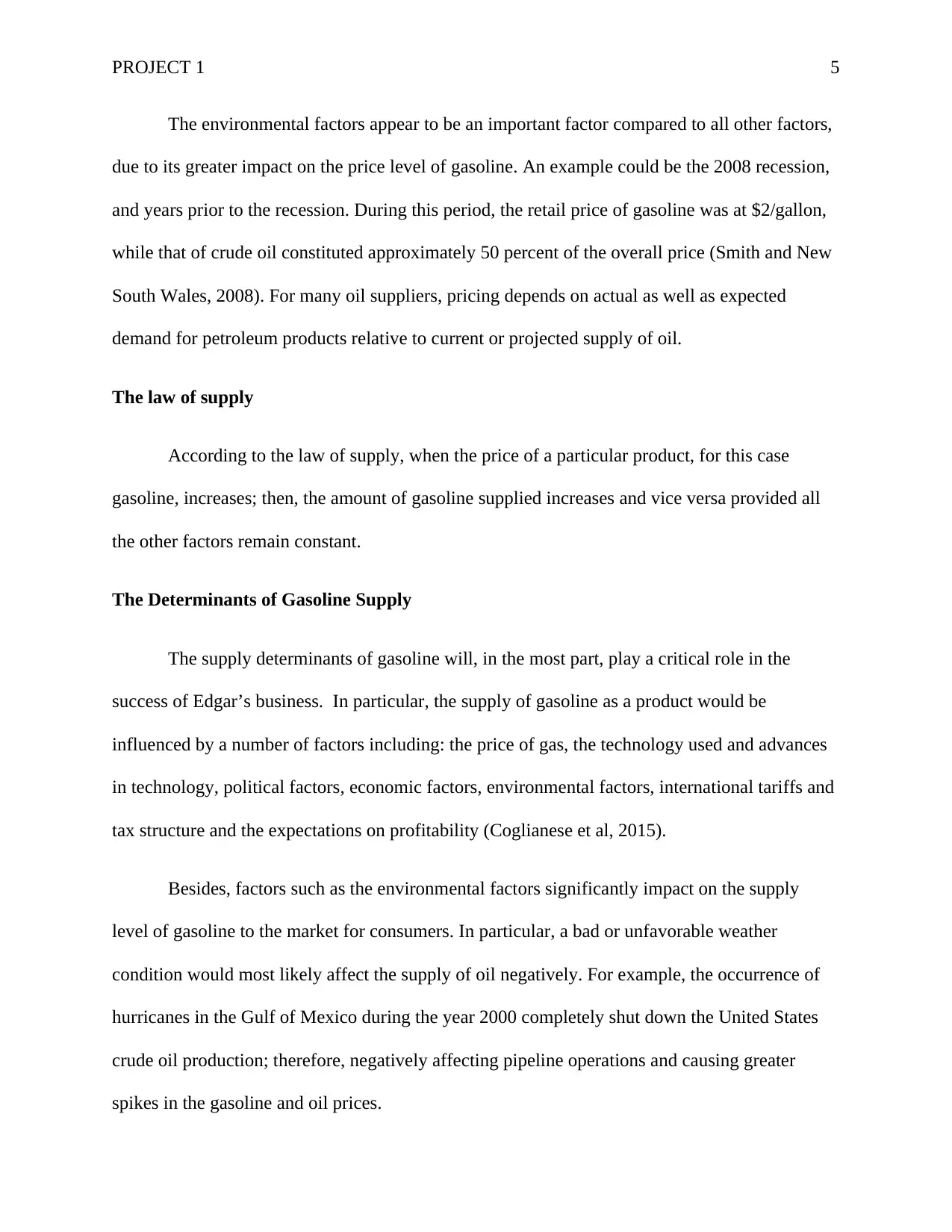
PROJECT 1 5
The environmental factors appear to be an important factor compared to all other factors,
due to its greater impact on the price level of gasoline. An example could be the 2008 recession,
and years prior to the recession. During this period, the retail price of gasoline was at $2/gallon,
while that of crude oil constituted approximately 50 percent of the overall price (Smith and New
South Wales, 2008). For many oil suppliers, pricing depends on actual as well as expected
demand for petroleum products relative to current or projected supply of oil.
The law of supply
According to the law of supply, when the price of a particular product, for this case
gasoline, increases; then, the amount of gasoline supplied increases and vice versa provided all
the other factors remain constant.
The Determinants of Gasoline Supply
The supply determinants of gasoline will, in the most part, play a critical role in the
success of Edgar’s business. In particular, the supply of gasoline as a product would be
influenced by a number of factors including: the price of gas, the technology used and advances
in technology, political factors, economic factors, environmental factors, international tariffs and
tax structure and the expectations on profitability (Coglianese et al, 2015).
Besides, factors such as the environmental factors significantly impact on the supply
level of gasoline to the market for consumers. In particular, a bad or unfavorable weather
condition would most likely affect the supply of oil negatively. For example, the occurrence of
hurricanes in the Gulf of Mexico during the year 2000 completely shut down the United States
crude oil production; therefore, negatively affecting pipeline operations and causing greater
spikes in the gasoline and oil prices.
The environmental factors appear to be an important factor compared to all other factors,
due to its greater impact on the price level of gasoline. An example could be the 2008 recession,
and years prior to the recession. During this period, the retail price of gasoline was at $2/gallon,
while that of crude oil constituted approximately 50 percent of the overall price (Smith and New
South Wales, 2008). For many oil suppliers, pricing depends on actual as well as expected
demand for petroleum products relative to current or projected supply of oil.
The law of supply
According to the law of supply, when the price of a particular product, for this case
gasoline, increases; then, the amount of gasoline supplied increases and vice versa provided all
the other factors remain constant.
The Determinants of Gasoline Supply
The supply determinants of gasoline will, in the most part, play a critical role in the
success of Edgar’s business. In particular, the supply of gasoline as a product would be
influenced by a number of factors including: the price of gas, the technology used and advances
in technology, political factors, economic factors, environmental factors, international tariffs and
tax structure and the expectations on profitability (Coglianese et al, 2015).
Besides, factors such as the environmental factors significantly impact on the supply
level of gasoline to the market for consumers. In particular, a bad or unfavorable weather
condition would most likely affect the supply of oil negatively. For example, the occurrence of
hurricanes in the Gulf of Mexico during the year 2000 completely shut down the United States
crude oil production; therefore, negatively affecting pipeline operations and causing greater
spikes in the gasoline and oil prices.
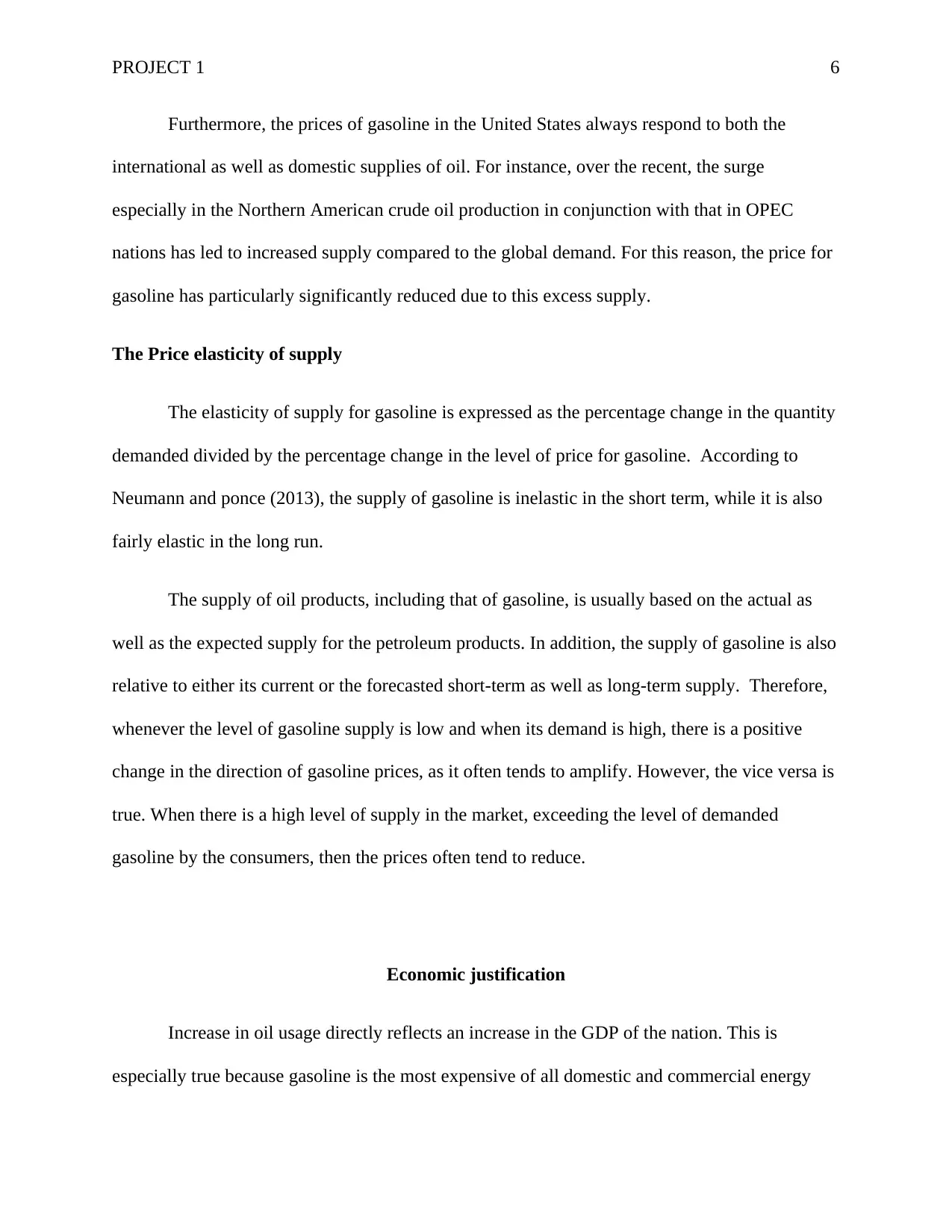
PROJECT 1 6
Furthermore, the prices of gasoline in the United States always respond to both the
international as well as domestic supplies of oil. For instance, over the recent, the surge
especially in the Northern American crude oil production in conjunction with that in OPEC
nations has led to increased supply compared to the global demand. For this reason, the price for
gasoline has particularly significantly reduced due to this excess supply.
The Price elasticity of supply
The elasticity of supply for gasoline is expressed as the percentage change in the quantity
demanded divided by the percentage change in the level of price for gasoline. According to
Neumann and ponce (2013), the supply of gasoline is inelastic in the short term, while it is also
fairly elastic in the long run.
The supply of oil products, including that of gasoline, is usually based on the actual as
well as the expected supply for the petroleum products. In addition, the supply of gasoline is also
relative to either its current or the forecasted short-term as well as long-term supply. Therefore,
whenever the level of gasoline supply is low and when its demand is high, there is a positive
change in the direction of gasoline prices, as it often tends to amplify. However, the vice versa is
true. When there is a high level of supply in the market, exceeding the level of demanded
gasoline by the consumers, then the prices often tend to reduce.
Economic justification
Increase in oil usage directly reflects an increase in the GDP of the nation. This is
especially true because gasoline is the most expensive of all domestic and commercial energy
Furthermore, the prices of gasoline in the United States always respond to both the
international as well as domestic supplies of oil. For instance, over the recent, the surge
especially in the Northern American crude oil production in conjunction with that in OPEC
nations has led to increased supply compared to the global demand. For this reason, the price for
gasoline has particularly significantly reduced due to this excess supply.
The Price elasticity of supply
The elasticity of supply for gasoline is expressed as the percentage change in the quantity
demanded divided by the percentage change in the level of price for gasoline. According to
Neumann and ponce (2013), the supply of gasoline is inelastic in the short term, while it is also
fairly elastic in the long run.
The supply of oil products, including that of gasoline, is usually based on the actual as
well as the expected supply for the petroleum products. In addition, the supply of gasoline is also
relative to either its current or the forecasted short-term as well as long-term supply. Therefore,
whenever the level of gasoline supply is low and when its demand is high, there is a positive
change in the direction of gasoline prices, as it often tends to amplify. However, the vice versa is
true. When there is a high level of supply in the market, exceeding the level of demanded
gasoline by the consumers, then the prices often tend to reduce.
Economic justification
Increase in oil usage directly reflects an increase in the GDP of the nation. This is
especially true because gasoline is the most expensive of all domestic and commercial energy
⊘ This is a preview!⊘
Do you want full access?
Subscribe today to unlock all pages.

Trusted by 1+ million students worldwide
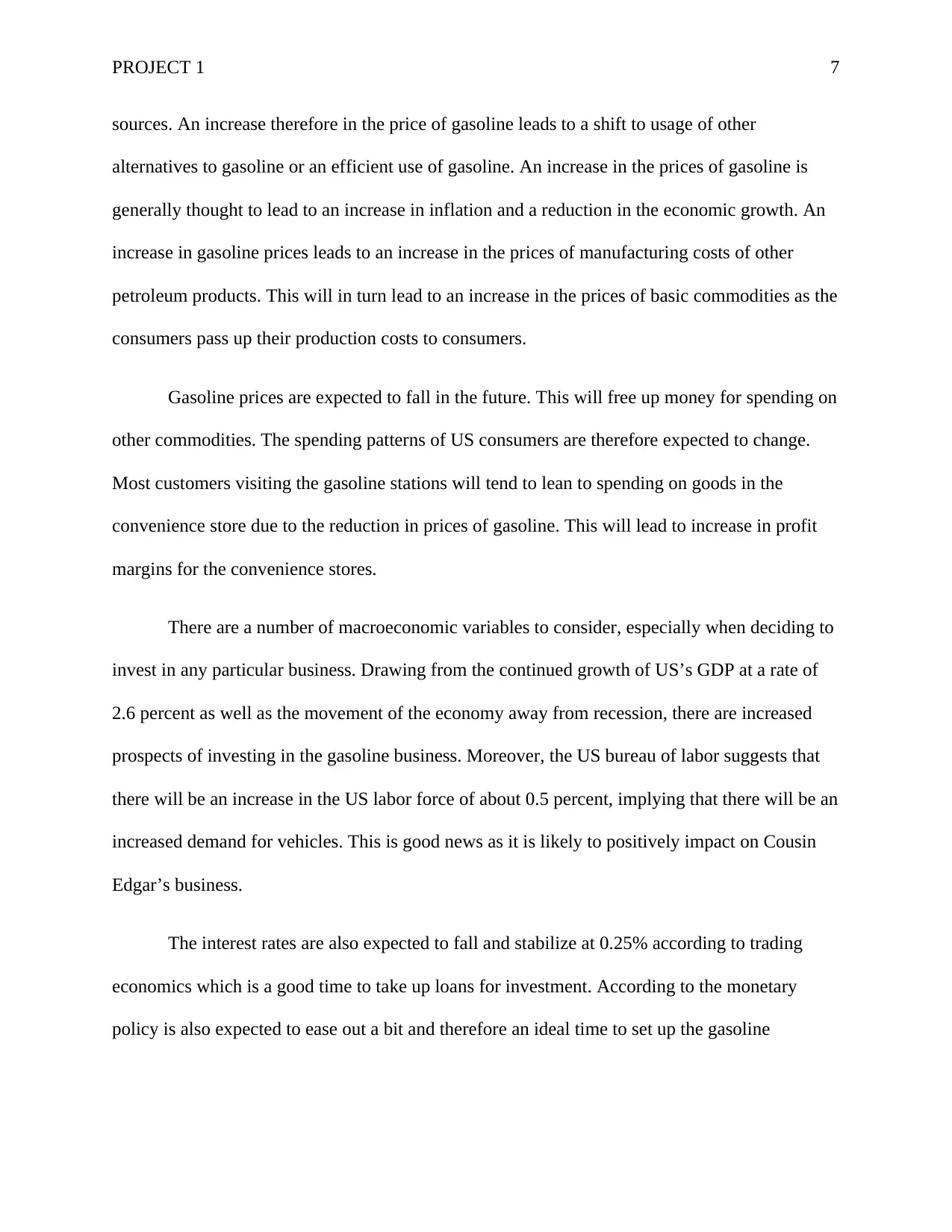
PROJECT 1 7
sources. An increase therefore in the price of gasoline leads to a shift to usage of other
alternatives to gasoline or an efficient use of gasoline. An increase in the prices of gasoline is
generally thought to lead to an increase in inflation and a reduction in the economic growth. An
increase in gasoline prices leads to an increase in the prices of manufacturing costs of other
petroleum products. This will in turn lead to an increase in the prices of basic commodities as the
consumers pass up their production costs to consumers.
Gasoline prices are expected to fall in the future. This will free up money for spending on
other commodities. The spending patterns of US consumers are therefore expected to change.
Most customers visiting the gasoline stations will tend to lean to spending on goods in the
convenience store due to the reduction in prices of gasoline. This will lead to increase in profit
margins for the convenience stores.
There are a number of macroeconomic variables to consider, especially when deciding to
invest in any particular business. Drawing from the continued growth of US’s GDP at a rate of
2.6 percent as well as the movement of the economy away from recession, there are increased
prospects of investing in the gasoline business. Moreover, the US bureau of labor suggests that
there will be an increase in the US labor force of about 0.5 percent, implying that there will be an
increased demand for vehicles. This is good news as it is likely to positively impact on Cousin
Edgar’s business.
The interest rates are also expected to fall and stabilize at 0.25% according to trading
economics which is a good time to take up loans for investment. According to the monetary
policy is also expected to ease out a bit and therefore an ideal time to set up the gasoline
sources. An increase therefore in the price of gasoline leads to a shift to usage of other
alternatives to gasoline or an efficient use of gasoline. An increase in the prices of gasoline is
generally thought to lead to an increase in inflation and a reduction in the economic growth. An
increase in gasoline prices leads to an increase in the prices of manufacturing costs of other
petroleum products. This will in turn lead to an increase in the prices of basic commodities as the
consumers pass up their production costs to consumers.
Gasoline prices are expected to fall in the future. This will free up money for spending on
other commodities. The spending patterns of US consumers are therefore expected to change.
Most customers visiting the gasoline stations will tend to lean to spending on goods in the
convenience store due to the reduction in prices of gasoline. This will lead to increase in profit
margins for the convenience stores.
There are a number of macroeconomic variables to consider, especially when deciding to
invest in any particular business. Drawing from the continued growth of US’s GDP at a rate of
2.6 percent as well as the movement of the economy away from recession, there are increased
prospects of investing in the gasoline business. Moreover, the US bureau of labor suggests that
there will be an increase in the US labor force of about 0.5 percent, implying that there will be an
increased demand for vehicles. This is good news as it is likely to positively impact on Cousin
Edgar’s business.
The interest rates are also expected to fall and stabilize at 0.25% according to trading
economics which is a good time to take up loans for investment. According to the monetary
policy is also expected to ease out a bit and therefore an ideal time to set up the gasoline
Paraphrase This Document
Need a fresh take? Get an instant paraphrase of this document with our AI Paraphraser
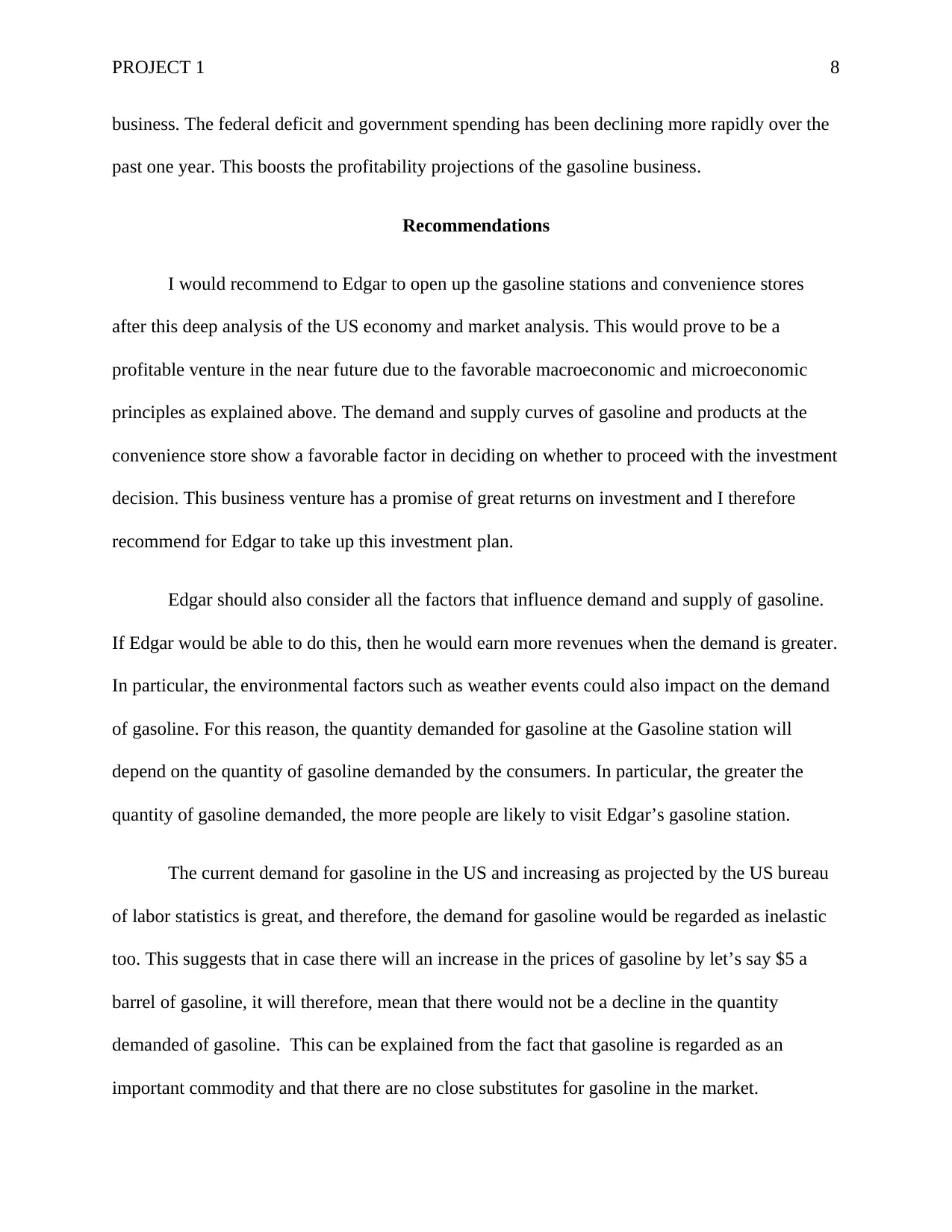
PROJECT 1 8
business. The federal deficit and government spending has been declining more rapidly over the
past one year. This boosts the profitability projections of the gasoline business.
Recommendations
I would recommend to Edgar to open up the gasoline stations and convenience stores
after this deep analysis of the US economy and market analysis. This would prove to be a
profitable venture in the near future due to the favorable macroeconomic and microeconomic
principles as explained above. The demand and supply curves of gasoline and products at the
convenience store show a favorable factor in deciding on whether to proceed with the investment
decision. This business venture has a promise of great returns on investment and I therefore
recommend for Edgar to take up this investment plan.
Edgar should also consider all the factors that influence demand and supply of gasoline.
If Edgar would be able to do this, then he would earn more revenues when the demand is greater.
In particular, the environmental factors such as weather events could also impact on the demand
of gasoline. For this reason, the quantity demanded for gasoline at the Gasoline station will
depend on the quantity of gasoline demanded by the consumers. In particular, the greater the
quantity of gasoline demanded, the more people are likely to visit Edgar’s gasoline station.
The current demand for gasoline in the US and increasing as projected by the US bureau
of labor statistics is great, and therefore, the demand for gasoline would be regarded as inelastic
too. This suggests that in case there will an increase in the prices of gasoline by let’s say $5 a
barrel of gasoline, it will therefore, mean that there would not be a decline in the quantity
demanded of gasoline. This can be explained from the fact that gasoline is regarded as an
important commodity and that there are no close substitutes for gasoline in the market.
business. The federal deficit and government spending has been declining more rapidly over the
past one year. This boosts the profitability projections of the gasoline business.
Recommendations
I would recommend to Edgar to open up the gasoline stations and convenience stores
after this deep analysis of the US economy and market analysis. This would prove to be a
profitable venture in the near future due to the favorable macroeconomic and microeconomic
principles as explained above. The demand and supply curves of gasoline and products at the
convenience store show a favorable factor in deciding on whether to proceed with the investment
decision. This business venture has a promise of great returns on investment and I therefore
recommend for Edgar to take up this investment plan.
Edgar should also consider all the factors that influence demand and supply of gasoline.
If Edgar would be able to do this, then he would earn more revenues when the demand is greater.
In particular, the environmental factors such as weather events could also impact on the demand
of gasoline. For this reason, the quantity demanded for gasoline at the Gasoline station will
depend on the quantity of gasoline demanded by the consumers. In particular, the greater the
quantity of gasoline demanded, the more people are likely to visit Edgar’s gasoline station.
The current demand for gasoline in the US and increasing as projected by the US bureau
of labor statistics is great, and therefore, the demand for gasoline would be regarded as inelastic
too. This suggests that in case there will an increase in the prices of gasoline by let’s say $5 a
barrel of gasoline, it will therefore, mean that there would not be a decline in the quantity
demanded of gasoline. This can be explained from the fact that gasoline is regarded as an
important commodity and that there are no close substitutes for gasoline in the market.
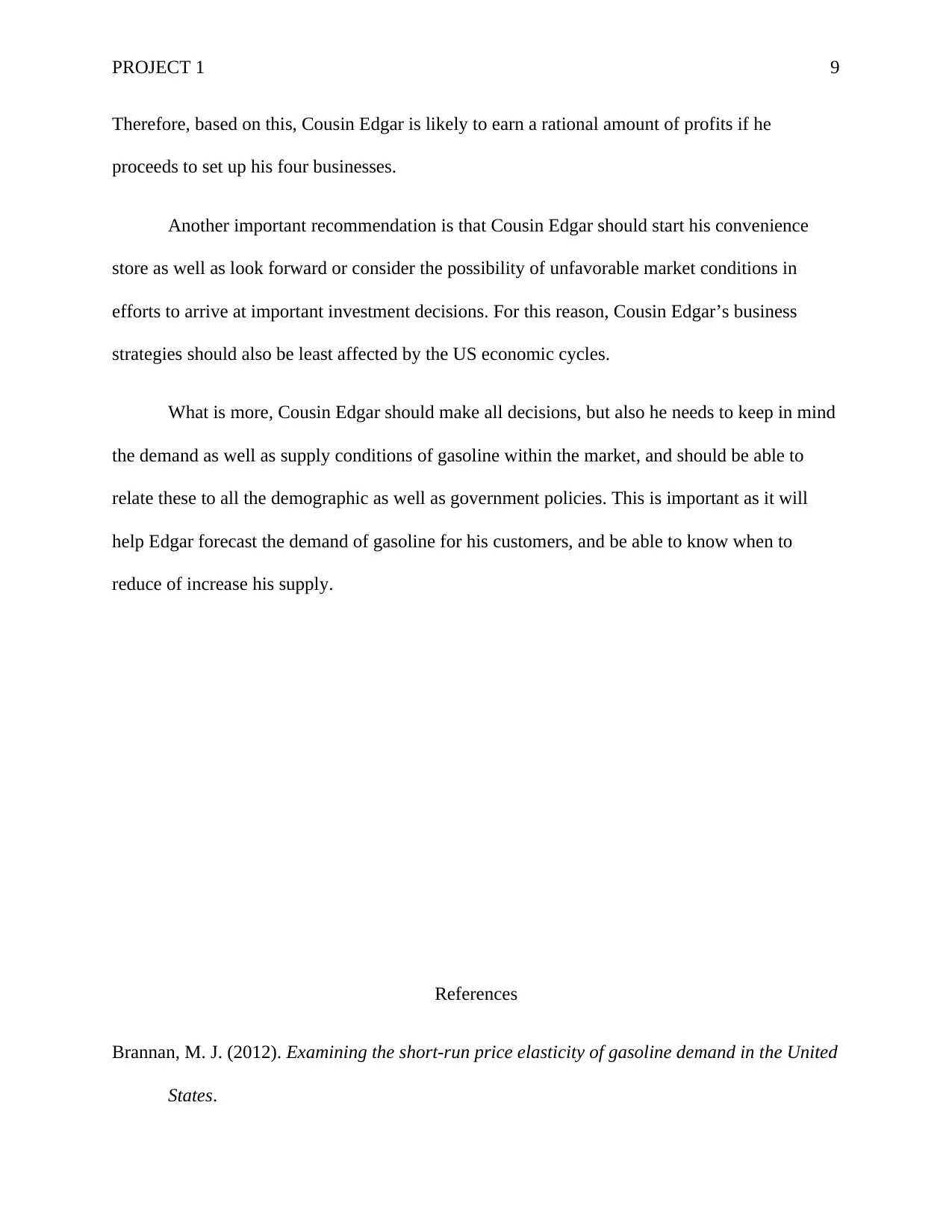
PROJECT 1 9
Therefore, based on this, Cousin Edgar is likely to earn a rational amount of profits if he
proceeds to set up his four businesses.
Another important recommendation is that Cousin Edgar should start his convenience
store as well as look forward or consider the possibility of unfavorable market conditions in
efforts to arrive at important investment decisions. For this reason, Cousin Edgar’s business
strategies should also be least affected by the US economic cycles.
What is more, Cousin Edgar should make all decisions, but also he needs to keep in mind
the demand as well as supply conditions of gasoline within the market, and should be able to
relate these to all the demographic as well as government policies. This is important as it will
help Edgar forecast the demand of gasoline for his customers, and be able to know when to
reduce of increase his supply.
References
Brannan, M. J. (2012). Examining the short-run price elasticity of gasoline demand in the United
States.
Therefore, based on this, Cousin Edgar is likely to earn a rational amount of profits if he
proceeds to set up his four businesses.
Another important recommendation is that Cousin Edgar should start his convenience
store as well as look forward or consider the possibility of unfavorable market conditions in
efforts to arrive at important investment decisions. For this reason, Cousin Edgar’s business
strategies should also be least affected by the US economic cycles.
What is more, Cousin Edgar should make all decisions, but also he needs to keep in mind
the demand as well as supply conditions of gasoline within the market, and should be able to
relate these to all the demographic as well as government policies. This is important as it will
help Edgar forecast the demand of gasoline for his customers, and be able to know when to
reduce of increase his supply.
References
Brannan, M. J. (2012). Examining the short-run price elasticity of gasoline demand in the United
States.
⊘ This is a preview!⊘
Do you want full access?
Subscribe today to unlock all pages.

Trusted by 1+ million students worldwide
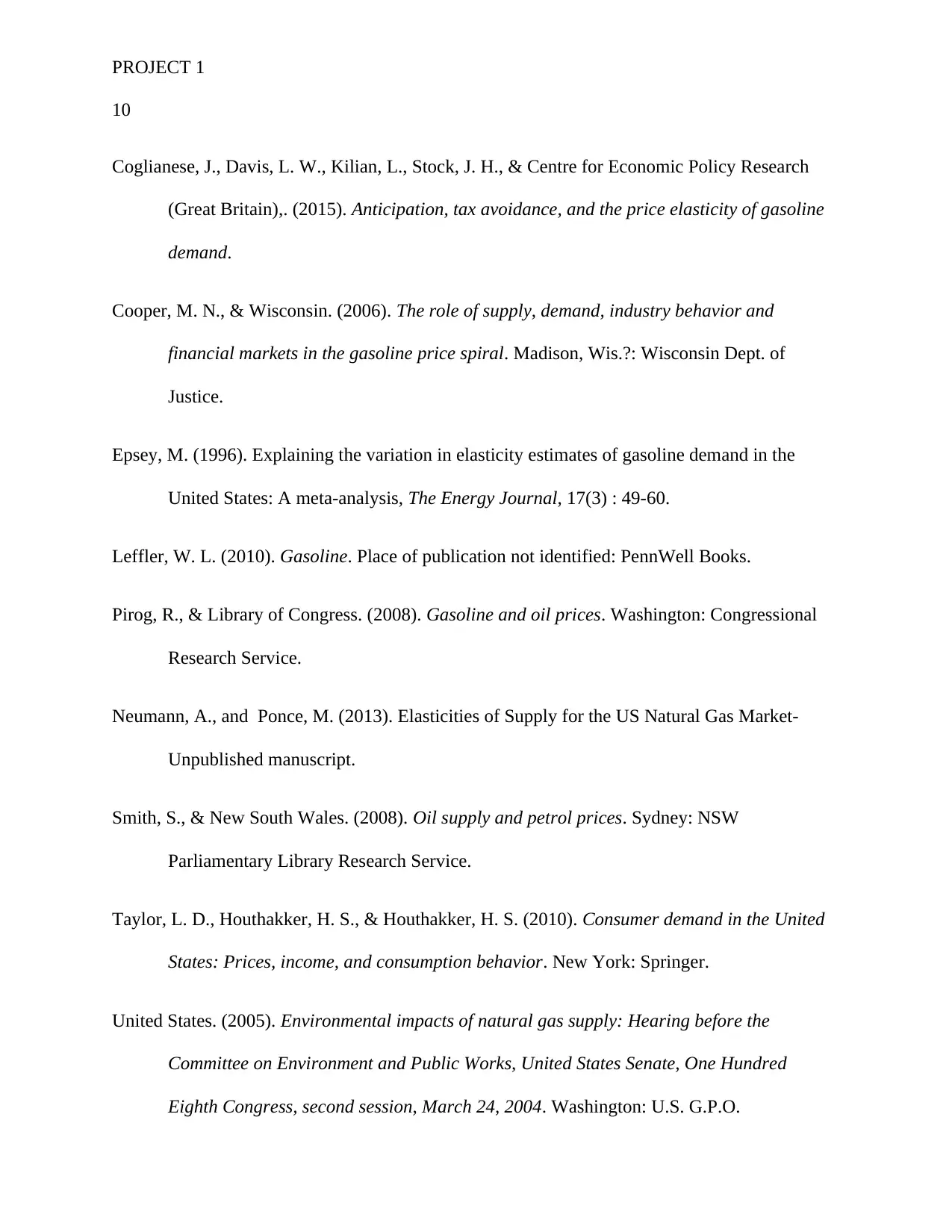
PROJECT 1
10
Coglianese, J., Davis, L. W., Kilian, L., Stock, J. H., & Centre for Economic Policy Research
(Great Britain),. (2015). Anticipation, tax avoidance, and the price elasticity of gasoline
demand.
Cooper, M. N., & Wisconsin. (2006). The role of supply, demand, industry behavior and
financial markets in the gasoline price spiral. Madison, Wis.?: Wisconsin Dept. of
Justice.
Epsey, M. (1996). Explaining the variation in elasticity estimates of gasoline demand in the
United States: A meta-analysis, The Energy Journal, 17(3) : 49-60.
Leffler, W. L. (2010). Gasoline. Place of publication not identified: PennWell Books.
Pirog, R., & Library of Congress. (2008). Gasoline and oil prices. Washington: Congressional
Research Service.
Neumann, A., and Ponce, M. (2013). Elasticities of Supply for the US Natural Gas Market-
Unpublished manuscript.
Smith, S., & New South Wales. (2008). Oil supply and petrol prices. Sydney: NSW
Parliamentary Library Research Service.
Taylor, L. D., Houthakker, H. S., & Houthakker, H. S. (2010). Consumer demand in the United
States: Prices, income, and consumption behavior. New York: Springer.
United States. (2005). Environmental impacts of natural gas supply: Hearing before the
Committee on Environment and Public Works, United States Senate, One Hundred
Eighth Congress, second session, March 24, 2004. Washington: U.S. G.P.O.
10
Coglianese, J., Davis, L. W., Kilian, L., Stock, J. H., & Centre for Economic Policy Research
(Great Britain),. (2015). Anticipation, tax avoidance, and the price elasticity of gasoline
demand.
Cooper, M. N., & Wisconsin. (2006). The role of supply, demand, industry behavior and
financial markets in the gasoline price spiral. Madison, Wis.?: Wisconsin Dept. of
Justice.
Epsey, M. (1996). Explaining the variation in elasticity estimates of gasoline demand in the
United States: A meta-analysis, The Energy Journal, 17(3) : 49-60.
Leffler, W. L. (2010). Gasoline. Place of publication not identified: PennWell Books.
Pirog, R., & Library of Congress. (2008). Gasoline and oil prices. Washington: Congressional
Research Service.
Neumann, A., and Ponce, M. (2013). Elasticities of Supply for the US Natural Gas Market-
Unpublished manuscript.
Smith, S., & New South Wales. (2008). Oil supply and petrol prices. Sydney: NSW
Parliamentary Library Research Service.
Taylor, L. D., Houthakker, H. S., & Houthakker, H. S. (2010). Consumer demand in the United
States: Prices, income, and consumption behavior. New York: Springer.
United States. (2005). Environmental impacts of natural gas supply: Hearing before the
Committee on Environment and Public Works, United States Senate, One Hundred
Eighth Congress, second session, March 24, 2004. Washington: U.S. G.P.O.
Paraphrase This Document
Need a fresh take? Get an instant paraphrase of this document with our AI Paraphraser

PROJECT 1
11
11
1 out of 11
Related Documents
Your All-in-One AI-Powered Toolkit for Academic Success.
+13062052269
info@desklib.com
Available 24*7 on WhatsApp / Email
![[object Object]](/_next/static/media/star-bottom.7253800d.svg)
Unlock your academic potential
Copyright © 2020–2025 A2Z Services. All Rights Reserved. Developed and managed by ZUCOL.





